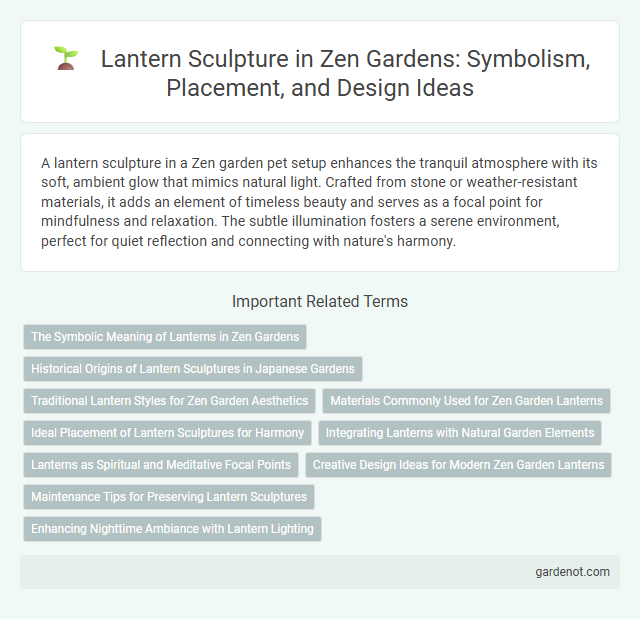A lantern sculpture in a Zen garden pet setup enhances the tranquil atmosphere with its soft, ambient glow that mimics natural light. Crafted from stone or weather-resistant materials, it adds an element of timeless beauty and serves as a focal point for mindfulness and relaxation. The subtle illumination fosters a serene environment, perfect for quiet reflection and connecting with nature's harmony.
The Symbolic Meaning of Lanterns in Zen Gardens
Lantern sculptures in Zen gardens symbolize illumination, enlightenment, and the path to spiritual awakening. Traditionally made from stone, these lanterns represent the light that dispels darkness, guiding practitioners through meditation and self-reflection. Their presence fosters tranquility and mindfulness, embodying the harmonious balance between nature and spiritual insight.
Historical Origins of Lantern Sculptures in Japanese Gardens
Lantern sculptures in Japanese gardens trace their origins to the Nara period (710-794 AD), initially introduced as spiritual symbols in Buddhist temple grounds. These iconic stone lanterns, known as "toro," served both practical purposes for lighting and symbolic meanings representing enlightenment and guidance. Over centuries, lanterns evolved into essential aesthetic elements, blending seamlessly with the natural landscape and embodying the principles of Zen philosophy and Japanese garden design.
Traditional Lantern Styles for Zen Garden Aesthetics
Traditional lantern styles in Zen gardens emphasize natural materials such as stone and feature minimalist designs inspired by Japanese heritage. Popular types include the Kasuga, Yukimi, and Oribe lanterns, each symbolizing harmony, illumination, and tranquility within the garden space. These sculptures enhance meditative ambiance, casting soft shadows and guiding visitors along serene pathways.
Materials Commonly Used for Zen Garden Lanterns
Zen garden lanterns are traditionally crafted from materials like granite, bronze, and weather-resistant stone, ensuring durability and a natural aesthetic. Some lantern sculptures also incorporate ceramic or cast iron, which provide intricate detailing and patina over time. These materials complement the tranquil ambiance of Zen gardens by blending smoothly with rocks, moss, and water elements.
Ideal Placement of Lantern Sculptures for Harmony
Lantern sculptures in Zen gardens are ideally placed near water features or along pathways to enhance tranquility and guide meditation. Positioning them at focal points with natural elements like stones and plants creates visual balance and spiritual harmony. Proper placement ensures soft illumination that complements the garden's minimalist aesthetic and promotes a serene atmosphere.
Integrating Lanterns with Natural Garden Elements
Lantern sculptures in Zen gardens harmonize with natural elements by using materials like stone, bamboo, and wood that reflect the surrounding environment. Placing lanterns near water features, moss, or carefully pruned trees enhances tranquility and highlights the balance between light and nature. This integration fosters a serene atmosphere, emphasizing simplicity and mindfulness through subtle illumination.
Lanterns as Spiritual and Meditative Focal Points
Lantern sculptures in Zen gardens serve as powerful spiritual and meditative focal points, symbolizing enlightenment and guidance. These lanterns often glow softly, creating a tranquil atmosphere conducive to deep reflection and mindfulness. Their presence encourages calmness, helping practitioners center their thoughts and connect with the serene energy of the garden.
Creative Design Ideas for Modern Zen Garden Lanterns
Modern Zen garden lanterns embrace minimalist geometric shapes and natural materials such as bamboo, stone, and weathered metal to create a serene ambiance. Innovative designs often incorporate solar-powered LED lights with adjustable brightness, enhancing tranquility while promoting sustainability. Sculptural elements like asymmetric frames or etched patterns reflect wabi-sabi aesthetics, blending tradition with contemporary artistry.
Maintenance Tips for Preserving Lantern Sculptures
Regular cleaning of lantern sculptures with a soft brush removes dust and prevents moss buildup, preserving their aesthetic appeal. Applying a protective sealant helps guard against weathering and corrosion, especially in outdoor Zen gardens exposed to rain and humidity. Inspecting for cracks or damage periodically ensures timely repairs, maintaining the sculpture's structural integrity and longevity.
Enhancing Nighttime Ambiance with Lantern Lighting
Lantern sculptures in a Zen garden create a tranquil and inviting nighttime ambiance by softly illuminating pathways and key features with warm, diffused light. The gentle glow emphasizes the garden's natural textures and shadows, fostering a meditative atmosphere ideal for relaxation and contemplation. Strategic placement of lantern lighting enhances spatial depth and highlights traditional elements, merging aesthetics with functionality.
Lantern sculpture Infographic

 gardenot.com
gardenot.com